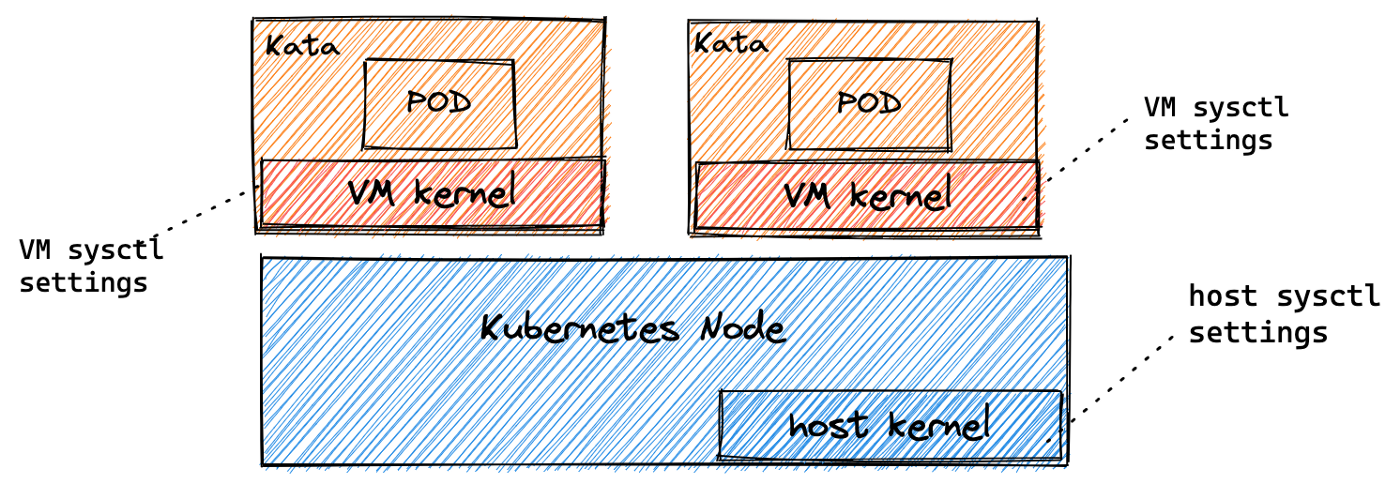A low-risk approach for Developers and Administrators
Linux provides the sysctl mechanism to modify the kernel behavior at runtime. There are many situations where this is desired. For example, tuning the kernel to run high-performance computing apps, configuring the application core dump settings, modifying network settings, experiments, etc.
Sysctl settings can be grouped into two categories:
- Namespaced: these can be set per POD in a Kubernetes cluster.
- System-wide: these are global and affect the entire Kubernetes node.
Further Kubernetes classifies namespaced sysctls as safe and unsafe. Safe sysctls are properly isolated and have no impact on other PODs running on the system. For detailed information please refer to the Kubernetes sysctl docs.
As you can infer, the setting of system-wide or unsafe sysctls will not be allowed as a general-purpose mechanism in a cluster.
So if you have a need for using these sysctls then what are your options today?
- Allocate a specific node or set of nodes.
- Use a VM-based container runtime allowing a separate kernel for each POD.
Allocating a specific node or set of nodes is a practical solution for specific classes of workload requiring the same settings. However, if there are different classes of workloads requiring different kernel settings then a better alternative is using VM-based container runtime.
Please remember there is no one size fits all approach. We have seen cases where both options are in use.
In this hands-on lab let’s see a few examples of how Kata containers, which is a VM-based container runtime can help meet your objectives for per POD kernel settings in a safe and low-risk manner.
Each Kata POD is using a separate kernel, so any sysctl setting only affects the specific POD. You can use a privileged InitContainer to modify the kernel settings.

Lab for Configuring Per Pod Kernel Settings
Prerequisites
- A Kubernetes Cluster bootstrapped and installed with kubeadm, kubectl and kubelet
- Container Runtime Interface (CRI) – Containerd or cri-o
Installation of Kata-Containers
The easiest way to deploy Kata containers in a Kubernetes cluster is via kata-deploy. This will run as a pod inside the kube-system namespace and will install all the binaries and artifacts needed to run Kata containers.
- Create and provision different RBAC roles to kata-deploy pod
kubectl apply -f https://raw.githubusercontent.com/kata-containers/kata-containers/main/tools/packaging/kata-deploy/kata-rbac/base/kata-rbac.yaml
- Then create a kata-deploy pod by deploying its stable version.
kubectl apply -f https://raw.githubusercontent.com/kata-containers/kata-containers/main/tools/packaging/kata-deploy/kata-deploy/base/kata-deploy-stable.yaml
- Check the kata-deploy pod status inside the
kube-systemnamespace.
kubectl get pods -n kube-system
kubectl -n kube-system wait --timeout=10m --for=condition=Ready -l name=kata-deploy pod
- Check the Kata-Containers labels on the node
kubectl get nodes --show-labels | grep kata
- After this configure a runtime class for Kata Containers by creating a Kubernetes resource
kind:RuntimeClass.
# runtimeclass.yaml
kind: RuntimeClass
apiVersion: node.k8s.io/v1
metadata:
name: kata-qemu
handler: kata-qemu
overhead:
podFixed:
memory: "160Mi"
cpu: "250m"
scheduling:
nodeSelector:
katacontainers.io/kata-runtime: "true"kubectl apply -f runtimeclass.yaml
Currently, we are creating a runtime class named kata-qemu (line 6) and this will be used to create pod running inside a VM. There are other runtime classes that can also be used according to the platforms like kata-clh is used with cloud hypervisor, kata-fc is used with firecracker.
In runtime class, pod overhead (line 7) has been defined which has memory and CPU overheads set for any pod using the specific runtime class.
- See more information about the
kata-qemuruntime class through
kubectl get runtimeclass
kubectl describe runtimeclass kata-qemu
Using InitContainer to set a specific sysctl
An advantage of using the privileged initContainer approach is that you don’t need to provide privileged access to the application container.
- Create a pod with init container and application container
# sysctl-initcont.yaml
apiVersion: v1
kind: Pod
metadata:
name: test-sysctl
spec:
runtimeClassName: kata-qemu
containers:
- name: test-sysctl
image: quay.io/fedora/fedora:35
command:
- sleep
- "infinity"
initContainers:
- name: init-sys
securityContext:
privileged: true
image: quay.io/fedora/fedora:35
command: ['sh', '-c', 'echo "65536" > /proc/sys/kernel/msgmax']kubectl apply -f sysctl-initcont.yaml
kubectl get pods
As shown below, resetting msgmax fails from the application container since it’s not privileged.
- Interact with the application container and try to set the value of
msgmax
kubectl exec -it test-sysctl -- bash
cat /proc/sys/kernel/msgmax
echo 4096 > /proc/sys/kernel/msgmax
Using InitContainer to set core-dump pattern
- Create a pod with init container and application container and run
sysctlcommand in init-container
# coredump-initcont.yaml
apiVersion: v1
kind: Pod
metadata:
name: test-coredump
spec:
runtimeClassName: kata-qemu
initContainers:
- name: init-coredump
image: busybox:1.28
command: ['sh', '-c', "sysctl -w kernel.core_pattern=core.%P.%u.%g.%s.%t.%c.%h.%e"]
securityContext:
privileged: true
containers:
- name: test-coredump
image: quay.io/fedora/fedora:35kubectl apply -f coredump-initcont.yaml
kubectl get pods
Conclusion
In this blog, we have learnt how to set per pod kernel settings with Kata containers.

